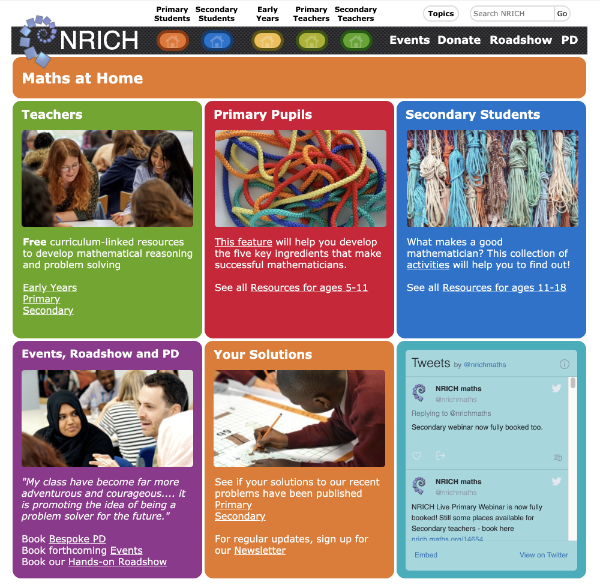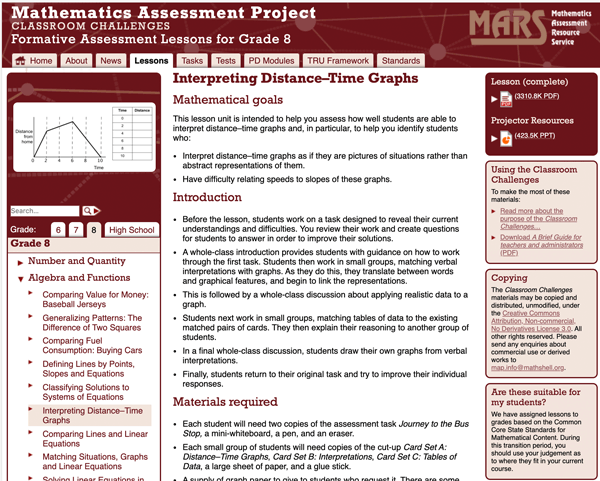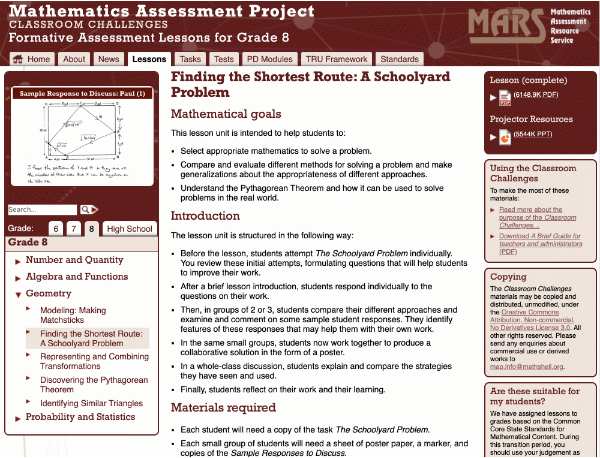30 Design Strategies and Tactics from 40 Years of Investigation
Appendix: Further information and examples
Varying lesson styles
In many mathematics classrooms every lesson has the same activity sequence on the same kinds of task – typically teacher explanation of the new topic, with a worked example involving a mathematical procedure, followed by students working through a set of similar tasks as exercises. No wonder most students find mathematics boring. Contrast this with the norm in English (or native language) classes, where there is a rich variety of styles of lesson, including reading or writing plays or poems, constructing persuasive arguments, critiquing texts including their own or their fellow-students in, for example, a ‘writing workshop’ – a well-defined sequence of activities, familiar to the students, through which their writing is developed from few line sketches to a substantial story over many pages. A similar conscious variation of styles is rare in mathematics materials. What styles might we usefully try to include?
We will distinguish between the styles of task that students are asked to tackle, and the styles of lesson activity sequence that can be used to support their learning.
Task styles
This is a well-established concept within mathematics. For example, Malcolm Swan identified and used the following task-types (or genres) that contribute to conceptual understanding:
- Interpreting and translating representations – What is another way of showing this?
- Classifying, naming and defining objects – What is the same and what is different?
- Testing assertions and misconceptions and justifying conjectures – Always, sometimes or never true?
- Modifying problems; exploring structure – What happens if I change this? How will it affect that?
- Études are designed, like their musical namesakes, to develop fluency in technical skills in a mathematically interesting activity. Colin Foster devised this new style.
Equally, there are well-recognised styles of problem solving and modelling tasks that ask students to:
- Plan an event
- Design an object
- Infer insights from a set of data
- Review and critique a model or analysis

Link to NRICH website
The mathematics education community has created or assembled an enormous collection of rich tasks under the broad generic heading
- Investigate this rich and interesting mathematical situation which you have not seen before.
A website known for tasks that stimulate learners’ mathematical thinking is NRICH. Colin Foster in his book Variety in Mathematics Lessons (Foster 2008) tackled this issue, emphasising variety of tasks and task sequences, including many of the types listed above.
Links to materials:
- NRICH
- http://nrich.maths.org/, nrich_website.png
Lesson styles
Among the community of highly sophisticated mathematics teachers, pedagogy tends to be discussed in broad general terms, if at all. This is reflected in this extract from the introduction to Colin Foster's thought-provoking book.
Variety in Mathematics Lessons collects together some more interesting lesson models. Although the book includes examples of lessons, it is not merely a set of lesson plans. In a way, it focuses on the stage before a lesson plan is formed – more like a plan for a lesson plan.
Nothing here should be taken as prescriptive. Professionals in their particular classrooms are the only people who are in the position to know their learners. Only they can take account of the many factors concerning the pupils and their teacher at a given moment. This book offers a collection of rough ‘templates’ for different genres of mathematics lesson.
However, handling these kinds of task in the classroom requires an ‘adaptive expertise’ (Hatano & Inagaki 1986) that is outside the pedagogy of many mathematics teachers. Could specific lesson formats, with well-defined activity sequences as in the ‘writers’ workshop', help teachers without a lot of prior experience with these kinds of task expand their expertise? This question was explored by many Shell Centre projects, more recently in the Mathematics Assessment Project (MAP map.mathshell.org ). The developmental feedback from the trials always suggested the guidance in the well-defined lesson structures was appreciated by the teachers – and worked well.
We describe below the two examples of lesson styles used in MAP. While each is readily accessible to lesson designers, the question as to how far a teacher could use either, inserting their own choice of mathematical tasks (as native-language teachers do with texts) remains unexplored.
The ‘diagnostic teaching’ style
This design for formative assessment is based on the following sequence of activities:
- Expose and explore students’ existing ideas – pull back the rug
- Confront them with their contradictions – provoke ‘cognitive conflict’
- Resolve conflict through discussion – allow time for formulation of new concepts
- Generalize, extend and link learning – connect to new contexts.
MAP version
The Mathematics Assessment Project's concept-development lessons (map.mathshell.org) are explicit examples of this approach with the following more detailed structure:
- Before teaching, explore existing conceptual frameworks through tests and interviews.
- Students’ intuitive interpretations or methods are identified through written tests and possibly follow-up clinical interviews.
- Make existing concepts and methods explicit in the classroom
- An initial activity is designed with the purpose of making students aware of their own intuitive interpretations and methods. At the beginning of a lesson, for example, students are asked to attempt a task individually, with no help from the teacher. No attempt is made, at this stage, to ‘teach’ anything new or even make students aware that errors have been made. The purpose here is expose pre-existing ways of thinking.
- Provoke and share ‘cognitive conflicts’.
- Feedback to the students is given in one of three ways:
- by asking students to compare their responses with those made by other students;
- by asking students to repeat the task using alternative methods;
- by using tasks which contain some form of built-in check.
This feedback produces ‘cognitive conflict’ when students begin to realize and confront the inconsistencies in their own interpretations and methods. Time is spent reflecting on and discussing the nature of this conflict. Students are asked to write down the inconsistencies and possible causes of error. This typically involves both small group and whole class discussion.
- Resolve conflict through discussion and formulate new concepts and methods.
- A whole class discussion is held in order to ‘resolve’ a conflict. Students are encouraged to articulate conflicting points of view and reformulate ideas. At this point, the teacher suggests, with reasons, a ‘mathematicians’ viewpoint.
- Consolidate learning by using the new concepts and methods on further problems.
- New learning is utilized and consolidated by
- offering further practice questions
- inviting students to create and solve their own problems within given constraints;
- asking students to analyse completed work and to diagnose causes of errors for themselves.

Link to materials
The lesson Interpreting Distance-Time Graphs exemplifies this model in action. Students first work on a graph interpretation ‘pre-assessment’ task designed to reveal their current understandings and difficulties. The teacher reviews their work and, guided by the support materials, prepares probing questions that will prompt students to improve their solutions. The main lesson centers on an activity in which students group cards containing written descriptions of situations with graphs and data tables. The cards have been designed to include possible ‘false matches’ revealing widely-held misconceptions such as seeing a distance/time graph as a picture of a hill or confusing speed with distance – students will have to tackle those misconceptions to ‘solve’ the activity. After a whole-class discussion to review the activity, students try drawing their own graph from verbal descriptions and, finally, tackle a similar task to the original pre-assessment.
This lesson pattern – including the ‘card matching’ activity is used several times in the MAP lessons.
Links to materials:
- MAP – Interpreting Distance-Time Graphs
- https://www.map.mathshell.org/lessons.php?unit=8225&collection=8
The modelling style
This style focuses on alternative solutions to a single rich problem, around which the lesson is built. This is a common version of the activity sequence:
- Each student has a go at the task
- Students share and compare their approaches in small groups, seeking to develop a better joint solution. The teacher observes, asking non-directive questions only where needed to ‘unjam’ the solution process. (Differentiation by need)
- The teacher asks a representative (who the teacher selects) from each of a few groups with different approaches to present their reasoning to the whole class.
- The teacher moderates a class discussion of the strengths and weaknesses of the solutions presented, and they might be evaluated by reference to the real world context.
- The teacher summarises and, perhaps, points to related problems or other extensions.
Problem solving within mathematics uses a similar sequence, but with evaluation built on internal logical consistency and potential power rather than empirical validation
MAP version
The Mathematics Assessment Project's problem solving lessons (map.mathshell.org) are explicit examples of this approach with the following more detailed structure:
- ‘Having a go’
- In a prior lesson the students spend around 20 minutes tackling an expert task, individually and unaided. Before the main lesson the teacher assesses the work, looking for different approaches and, with guidance from the ‘Common Issues’ table, prepares qualitative feedback in the form of questions – sometimes individually but often for the class.
- Reviewing critique
- In the main lesson the students review their own work in the light of the teacher’s feedback and write responses.
- Collaborating
- Students work in pairs or threes, with students sharing ideas and working to produce joint solutions.
- Critiquing
- Carefully chosen examples of other students' work using different mathematical methods are introduced. The groups are asked to review and critique the various solutions, in their groups, then as a whole class discussion.
- Integrating
- Whole class discussion focuses on the payoff of mathematics at different levels. (The sample student work enables the designers to show more powerful mathematics than is likely to arise in a typical class. (This helps to defuse the common “the math is not up to grade” criticism.)
- Improving
- Students improve their solutions to the initial problem, or one much like it.
- Reflecting
- Finally, in a period of individual reflection, students write about what they have learned.

Link to materials
The lesson Finding the Shortest Route – A Schoolyard Problem exemplifies this process. As with several other MAP lessons in this genre, the collaborative work centers on preparing a poster that explains the group’s solution – this also makes it easier for the teacher to see how students are tackling the problem, without unnecessary intervention, as they tour the classroom.
Overall question: What ideas for other lesson styles are worth developing and exploring?
Links to materials:
- MAP – Finding the Shortest Route
- https://www.map.mathshell.org/lessons.php?unit=8305&collection=8, map_schoolyard.png
References
Foster, C. (2008) Variety in Mathematics Lessons. Derby: Association of Teachers of Mathematics.
Hatano, G., & Inagaki, K. (1986). Two courses of expertise. In H. W. Stevenson, H. Azuma & K. Hakuta (Eds.), Child development and education in Japan (pp. 262–272). New York: W H Freeman/Times Books/ Henry Holt & Co.